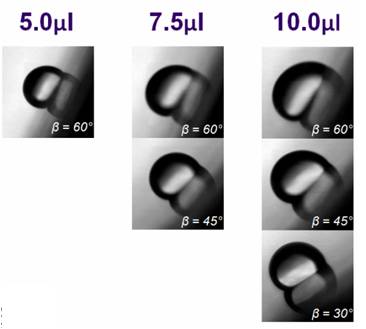CTRC Breakthroughs
Electrically Actuated Microscale Flows
Research Topics
Microscale Transport and Microchannels
Electrically Actuated Microscale Flows
Thin-Film Transport, Wicks and Heat Pipes
Novel Air and Impingement Cooling Approaches
Surface and Interface Engineering
Thermal Materials R&D
Thermal Interfaces
Small-Scale Refrigeration
Exploratory and Novel Concepts
Renewable and Sustainable Energy
Enhanced Electrohydrodynamic Micropump
 The enhanced electrohydrodynamic micropump design
consists of a traveling-wave electrode array in contact with a fluid
that moves ions induced in the fluid domain with the traveling
electric field. Higher phase representations of the traveling-wave
(for a given wavelength), in addition to an increase in electric
field strength by electrode design modifications have been shown to
increase flow rate by approximately 75%. A microfabricated pump has
also been completed to benchmark modeling results. A peak in the
velocity has been observed at a frequency that corresponds to the
charge relaxation time of an ion in the fluid. Additionally, the
effect of externally applied heat to increase the temperature
gradient (necessary for ion induction) has been demonstrated
experimentally. A velocity increase of approximately 50% was
observed with an additional 0.3 W of heat flux applied on one
boundary. Using the validated numerical model, the capability of
removing heat with electrohydrodynamic micropumping has been
evaluated. The figures show device layout and instrumentation of an
electrohydrodynamic micropump.
The enhanced electrohydrodynamic micropump design
consists of a traveling-wave electrode array in contact with a fluid
that moves ions induced in the fluid domain with the traveling
electric field. Higher phase representations of the traveling-wave
(for a given wavelength), in addition to an increase in electric
field strength by electrode design modifications have been shown to
increase flow rate by approximately 75%. A microfabricated pump has
also been completed to benchmark modeling results. A peak in the
velocity has been observed at a frequency that corresponds to the
charge relaxation time of an ion in the fluid. Additionally, the
effect of externally applied heat to increase the temperature
gradient (necessary for ion induction) has been demonstrated
experimentally. A velocity increase of approximately 50% was
observed with an additional 0.3 W of heat flux applied on one
boundary. Using the validated numerical model, the capability of
removing heat with electrohydrodynamic micropumping has been
evaluated. The figures show device layout and instrumentation of an
electrohydrodynamic micropump.
 A generic modeling framework was developed to predict
the electrical actuation of low electrical conductivity and
insulating liquid droplets using AC and DC voltages. Detailed and
careful measurements of droplet velocities (of different types of
liquids) under electrical actuation were carried out in a specially
designed setup. Electrowetting-induced Cassie (nonwetting) to Wenzel
(wetting) transition on superhydrophobic surfaces was studied
analytically and experimentally. The microscale surface design
enabled the first reported direct visual confirmation of the
electrowetting-induced Cassie-Wenzel transition. A careful
experimental study of heat transfer due to droplet motion on a hot
inclined substrate was carried out as part of the FRS project. A
numerical model was developed to calculate heat transfer coefficient
due to droplet motion on a single plate and droplet motion
sandwiched between two plates. Dynamic contact angle and contact
radius were measured experimentally for a wide range of frequencies
at different AC voltages. A numerical modeling technique was
developed to predict droplet retention under gravitational forces.
A generic modeling framework was developed to predict
the electrical actuation of low electrical conductivity and
insulating liquid droplets using AC and DC voltages. Detailed and
careful measurements of droplet velocities (of different types of
liquids) under electrical actuation were carried out in a specially
designed setup. Electrowetting-induced Cassie (nonwetting) to Wenzel
(wetting) transition on superhydrophobic surfaces was studied
analytically and experimentally. The microscale surface design
enabled the first reported direct visual confirmation of the
electrowetting-induced Cassie-Wenzel transition. A careful
experimental study of heat transfer due to droplet motion on a hot
inclined substrate was carried out as part of the FRS project. A
numerical model was developed to calculate heat transfer coefficient
due to droplet motion on a single plate and droplet motion
sandwiched between two plates. Dynamic contact angle and contact
radius were measured experimentally for a wide range of frequencies
at different AC voltages. A numerical modeling technique was
developed to predict droplet retention under gravitational forces.



